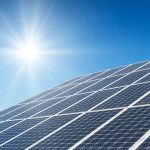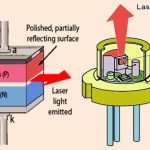This one is the most popular diodes used in our daily life. This is also a normal PN junction diode except that instead of silicon and germanium, the materials like gallium arsenide, gallium arsenide phosphide are used in its construction.
The figure below shows the symbol of a Light emitting diode.

Like a normal PN junction diode, this is connected in forward bias condition so that the diode conducts. The conduction takes place in a LED when the free electrons in the conduction band combine with the holes in the valence band. This process of recombination emits light. This process is called as Electroluminescence. The color of the light emitted depends upon the gap between the energy bands.
The materials used also effect the colors like, gallium arsenide phosphide emits either red or yellow, gallium phosphide emits either red or green and gallium nitrate emits blue light. Whereas gallium arsenide emits infrared light. The LEDs for non-visible Infrared light are used mostly in remote controls.
The following figure shows a how the practical LEDs of different colors looks like.

LED in the above figure has a flat side and curved side, the lead at the flat side is made shorter than the other one, so as to indicate that the shorter one is Cathode or negative terminal and the other one is Anode or the Positive terminal.
The basic structure of LED is as shown in the figure below.

As shown in the above figure, as the electrons jump into the holes, the energy is dissipated spontaneously in the form of light. LED is a current dependent device. The output light intensity depends upon the current through the diode.
Advantages of LED
There are many advantages of LED such as −
- High efficiency
- High speed
- High reliability
- Low heat dissipation
- Larger life span
- Low cost
- Easily controlled and programmable
- High levels of brightness and intensity
- Low voltage and current requirements
- Less wiring required
- Low maintenance cost
- No UV radiation
- Instant Lighting effect
Applications of LED
There are many applications for LED such as −
In Displays
- Especially used for seven segment display
- Digital clocks
- Microwave ovens
- Traffic signaling
- Display boards in railways and public places
- Toys
In Electronic Appliances
- Stereo tuners
- Calculators
- DC power supplies
- On/Off indicators in amplifiers
- Power indicators
Commercial Use
- Infrared readable machines
- Barcode readers
- Solid state video displays
Optical Communications
- In Optical switching applications
- For Optical coupling where manual help is unavailable
- Information transfer through FOC
- Image sensing circuits
- Burglar alarms
- In Railway signaling techniques
- Door and other security control systems
Just as LED has many advantages and applications, there is another important diode called Laser diode, which also has got many advanced features and scope of future. Let us discuss about Laser diode.


